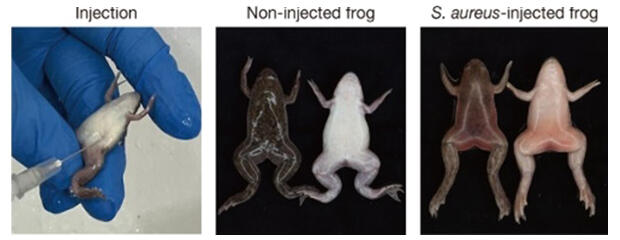African clawed frogs (Xenopus laevis) can be used as an infection model for human pathogenic bacteria such as Staphylococcus aureus and Pseudomonas aeruginosa, serving as an alternative to mice. This was discovered by a research group led by Graduate Student Ayano Kuriu of the Graduate School of Medicine, Dentistry, and Pharmaceutical Sciences, and Assistant Professor Kazuya Ishikawa, Associate Professor Kazuyuki Furuta, and Professor Chikara Kaito from the Faculty of Medicine, Dentistry, and Pharmaceutical Sciences at Okayama University. Their research was selected as the cover image for the June issue of Infection and Immunity.

Kuriu A, Ishikawa K, Tsuchiya K, Furuta K, Kaito C. Xenopus laevis as an infection model for human pathogenic bacteria. Infect Immun. 2025 Jun 10;93(6):e0012625. doi: 10.1128/iai.00126-25. Epub 2025 May 1. CC BY 4.0.
Understanding the mechanisms of bacterial pathogenicity requires infection experiments using animal models. However, mammalian infection models such as mice are expensive, and conducting exploratory studies using large numbers of individuals is difficult due to ethical issues. Although infection models using silkworms, fruit flies, and nematodes have been utilized, they present challenges as their immune systems and respiratory patterns differ from those of humans.
The research group analyzed whether African clawed frogs, which possess immune systems and respiratory patterns similar to mammals and have been used as model animals in developmental biology, could be utilized as infection models for human pathogenic bacteria.
When Staphylococcus aureus, Pseudomonas aeruginosa, and Listeria monocytogenes were injected intraperitoneally, the African clawed frogs died. The infection-related deaths caused by S. aureus and P. aeruginosa were suppressed by antimicrobial drug administration.
Additionally, when genes related to the pathogenicity of S. aureus and L. monocytogenes were deleted, their lethal effects on African clawed frogs were reduced. After injection with S. aureus, the bacteria were detected in the blood, liver, and muscle of the African clawed frogs, suggesting that they cause systemic infection.
These results suggest that African clawed frogs can be used as systemic infection models for human pathogenic bacteria and are useful for exploring pathogenic genes of human pathogenic bacteria and evaluating the effectiveness of antimicrobial drugs.
Journal Information
Publication: Infection and Immunity
Title: Xenopus laevis as an infection model for human pathogenic bacteria
DOI: 10.1128/iai.00126-25
This article has been translated by JST with permission from The Science News Ltd. (https://sci-news.co.jp/). Unauthorized reproduction of the article and photographs is prohibited.




